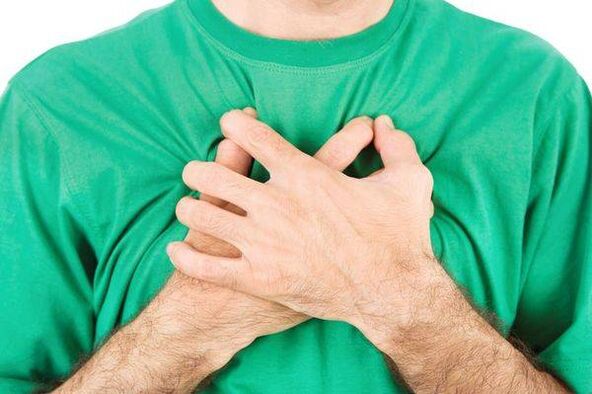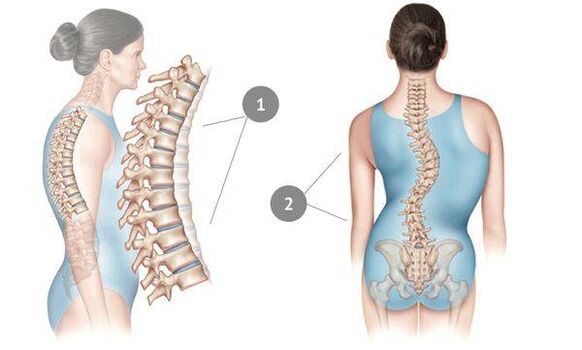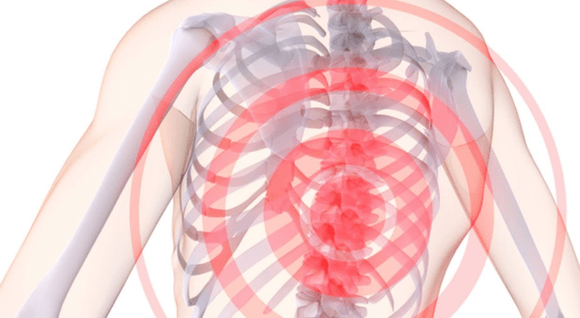Osteochondrosis is commonly referred to as dystrophic changes in the bones and connective tissue of the spine. The spine cannot take normal loads - this is mainly a manifestation of pain, not clearly expressed at first, but more and more over time.
main symptoms of the disease
Osteochondrosis of the thoracic spine is a disorder that usually presents in adulthood and does not fully manifest for a long time. This is because the thoracic spine naturally supports and anchors the ribs - thus, providing good protection for the intervertebral discs.

In this disease, the disc core becomes thin and dry, the surrounding fibrous tissue begins to collapse, and the cartilage tissue undergoes negative changes. The spine cannot take normal loads - this is mainly a manifestation of pain, not clearly expressed at first, but more and more over time. However, with a lot of load -- a sedentary lifestyle, a sedentary job, constant stress, poor posture, and back injuries -- osteochondrosis can affect the chest area sooner or later. The disease is thought to be very common - one in three adults suffers from it.
What are the symptoms of thoracic osteochondrosis? First, in the occurrence of pain, including:
- Interscapular and intercostal neuralgia shots;
- pain on the left side of the chest;
- pain in the arm, aggravated by lifting and reaching to the fingertips;
- soreness when bending over;
Additionally, thoracic osteochondrosis can manifest as numbness—not just in the chest, but in various parts of the body. Osteochondrosis can sometimes cause speech problems, and sometimes it can even cause peeling skin, brittle nails, itchy skin, and digestive disturbances.
Pain in thoracic osteochondrosis can manifest in different ways. Sometimes these are mild tingling or dull aches that manifest in the late afternoon and go away after physical activity - for example, a short walk. Typically, this is how the initial stages of thoracic osteochondrosis proceed when the intervertebral disc has not yet been deeply affected.

Later in the development of the disease, pain symptoms often manifest in the form of low back pain. The pain is pronounced, severe, interferes with normal breathing, and unnecessary movement will only make the situation worse. Often, back pain occurs after prolonged periods of inactivity—for example, working in a static position in front of a computer for hours.
The special "cunning" of thoracic osteochondrosis is that the disease can subtly disguise itself as a dozen other diseases. Thoracic osteochondrosis is easily confused with symptoms of pneumonia, angina, ischemia, and heart disease. Sometimes the disorder is more like renal colic or hepatic colic, with speech difficulties and numbness in different parts of the body even confused with signs of a stroke.
Furthermore, mistakes are made not only by patients themselves, but also by experienced physicians - making the diagnosis of the disease very complicated. It is especially difficult to identify thoracic osteochondrosis in its early stages - which is why it is often diagnosed when the disease has already become apparent and has entered a chronic phase.
At the same time, the timely diagnosis of thoracic vertebral osteochondrosis is also crucial. This allows you to start treatment immediately and slow the progression of the disease, thereby significantly stopping the pain symptoms that accompany the disease.
How dangerous is thoracic osteochondrosis?
Osteochondrosis of the thoracic spine does not pose a direct threat to the patient's life. However, in a neglected state, it can lead to serious complications:
- The appearance of chronic intercostal neuralgia;
- Thoracic hernia;
- Compression of the spinal cord in the damaged area of the spine.
Osteochondrosis of the spine manifests as scoliosis, sometimes the disease metastasizes to the cervical spine and causes loss of voice.
In addition, strong weakening of the spine in the thoracic region can lead to deformation of the peritoneal organs. This, in turn, can lead to various diseases of the digestive tract - stomach, pancreas, liver, kidneys, biliary tract.
Thoracic osteochondrosis requires careful treatment, which will help slow the progression of the disease long-term, prevent complications—and completely neutralize the symptoms of the disease in its early stages.
How is the disease treated?
What are the treatments for thoracic osteochondrosis? First, a thorough diagnosis is carried out, including examination of the patient by a specialist and examination using modern equipment. This allows you to accurately diagnose and ensure that we are talking about osteochondrosis and not another disease.
After a diagnosis is made, doctors can treat it in the following ways:
- Medicines designed to relieve pain symptoms;
- physiotherapy, laser therapy, acupuncture and reflexology;
- Manual therapy and therapeutic massage;
- Special classes in medical gymnastics.

Almost all of these methods are not designed to eliminate osteochondrosis, but to relieve inflammation and reduce the severity of pain. Removing pain is the main goal of treating thoracic osteochondrosis. At the same time, manual therapy and exercise therapy can "straighten" the spine, increasing the distance between the vertebrae and preventing compression. However, patients need to perform therapeutic exercises on a regular basis - otherwise it will not produce any results.
In some cases, especially severe cases, surgical treatment of thoracic osteochondrosis may be used. In this case, the affected vertebrae are replaced with prostheses—practice shows that this procedure is effective in about 50 percent of patients.
For thoracic osteochondrosis, regular visits to health resorts are recommended. In nursing home conditions, the patient received a well-established complex therapy combining drugs, physiotherapy and gymnastics - and over a long period of time, his condition improved significantly.
folk remedies
In the acute course of the disease, it is recommended to treat osteochondrosis of the thoracic spine in a quiescent state. But if your symptoms are mild, you don't have to go to the hospital. In this case, home care is crucial. Treating osteochondrosis with folk remedies is not only possible, but necessary—sometimes they are as effective as official medical procedures.
The goals of home remedies are the same - to quickly eliminate pain and inflammation and relieve symptoms of the disease. Therefore, in the treatment of osteochondrosis with folk remedies, decoctions, ointments, compresses and infusions of herbs and plants with sedative, analgesic and anti-inflammatory properties are used.
What herbs are recommended for people with osteochondrosis to replace tea? These are chamomile, calendula, sage, birch leaves, strawberry leaves and ripe viburnum. Also, these charges can be mixed with each other - an aromatic hot drink from two or three different herbs will have a noticeable effect.

Decoctions are brewed in the same way as tea - a tablespoon of the medicinal plant is poured into a cup of hot water, infused and drunk two to three times a day. While taking painkillers and anti-inflammatory drugs, it is recommended to drink a soothing infusion of motherwort, lavender, and valerian - stress is inevitable in the course of the disease and will further aggravate symptoms.
In addition to medicinal decoctions, use baths that contain medicinal additives - for example, extracts of celandine, plantain, and pine needles have a calming and warming effect. Such baths can relieve muscle spasms, improve blood flow between inflamed discs in the spine, and reduce inflammation.
Compression, ointment and rubbing are not recommended during acute pain. However, they can be used during remission. For example, rubbing with mustard camphor ointment is popular - 50g of mustard and camphor are diluted with 100ml of alcohol and 100g of raw egg whites and whisked until smooth. Apply the ointment to the back for two weeks at night - the treated area must be covered with a fleece cloth on top.
What should I do if my condition worsens?
What is considered an exacerbation of the disease? This term refers to a severe pain sensation. If the patient experiences significant discomfort, familiar back pain, and dull chest pains radiating to the peritoneum, lower back, and arms, it is time to focus on your illness with the greatest possible attention.

During exacerbations, it is recommended to:
- Avoid hypothermia and stress;
- Stay as still as possible to keep the load on the spine;
- Use non-irritating dressings and ointments on the affected area;
- Gently massage the affected area yourself - but avoid intense pressure;
- Continue your physical therapy exercises to the best of your ability -- but only if it doesn't make the pain worse.
In acute complications, bed rest is also recommended. Hospitalization may even be possible if excruciating pain occurs. But in most cases, the worsening of thoracic osteochondrosis can be stopped at home, especially if you combine a retention regimen with taking medications prescribed by a specialist.
The main condition for the worsening of osteochondrosis is lack of physical activity. An inflamed disc needs maximum rest—before it can quickly respond to deterioration.




























